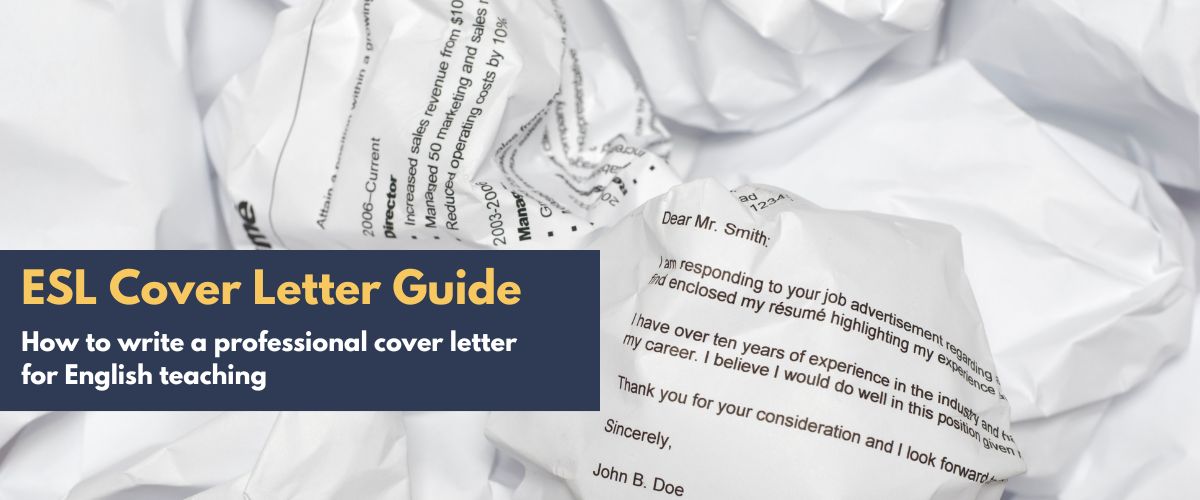
ESL Cover letter guide: How to write a professional cover letter for English teaching
To best prepare yourself before starting to apply for English teaching jobs, you’re going to want to craft a professional-looking cover letter. Unfortunately, this is a crucial step that many teachers forget to include! In this guide, we’re going to take a closer look at how you can prepare a professional cover letter that is suitable for English teaching.
Pursuing a career as an English teacher can be a very rewarding career path, as you’ll have the opportunity to work in a range of environments and destinations, while also being able to make an impact on people’s lives.
After finishing your 120-hour TESOL/TEFL course, you are finally ready to take the next step in launching your English teaching career, which is applying for teaching jobs.
In addition to obtaining your teaching certificate, you are also going to need to prepare a professional and engaging cover letter, as well as an eye-catching and inviting resume before you are ready to send in your applications. Understanding the importance of these documents, as well as how to skillfully craft them will allow you to present the recruiter with the very best sides of you.
Unfortunately, many aspiring teachers get stuck at this stage, as they are often unfamiliar with what an ESL teacher should include in their application material. Truth be told, applying for ESL teaching jobs is most of the time not that different from applying for any other regular job. The only difference is that you are going to have to pay extra attention to what you include in your resume and cover letter.
In this guide, we’ll take a closer look at how to write a professional cover letter for English teaching positions. The guide will cover what parts to include, how to structure them, and finally a template with examples that you can use as a base for your own cover letter.
Let’s get started!
💡 Tips! You haven’t missed our ESL resume guide, right? In addition to preparing a cover letter, you’ll also need a resume that factually details your work experience and qualifications.
Learn how to craft a professional-looking resume with our ultimate ESL resume guide.
.

Resume VS Cover letter
Before we get started with the guide, let’s quickly go over the difference between a cover letter and a resume, so that you will have an easier time understanding what to include where. It’s easy to confuse the two, as they both serve as a complement to the other.
🔎 What is the difference?
Resume:
The purpose of your resume is to factually summarize a brief list of your educational background, work experience and professional skills. The format usually focuses on using bullet points to list your information in reverse chronological order. Make sure that you keep it to a good length, use an appropriate layout, and focus on relevant information.
Cover letter:
The purpose of your cover letter is to go into more detail on how your experience and professional skills match the position you are applying for. This is a great opportunity to showcase more of your personality, as well as highlight why you are a good fit for the company. Compared to your resume, the cover letter format follows more of a business letter style with flowing text.
It’s good to remember that both documents should support each other, so make sure that they stay consistent and don’t contradict each other.
Why is a cover letter important to include in your application?
By including your cover letter in your application, you’ll be able to give the recruiter a better glimpse of who you are, what your qualifications are, and why you are a suitable candidate for the position.
Just including a resume/CV is often not enough, as it is too factual and brief to show the recruiter what kind of teacher they will be hiring. Recruiting is not just about finding a candidate with the right qualifications, recruiters also take into consideration your personality and fit in the company.
Getting your TESOL/TEFL certificate: Launch a career as a professional English teacher with our dually accredited 120-hour TESOL/TEFL course.
If you’d like to learn more about the course and how to enroll, you can do so here:
.
What should your ESL cover letter contain?
A good cover letter should be a written summary of who you are, what your relevant qualifications and work experiences are, as well as why you are the right person for the position that you are applying for.
Remember to thoroughly study the position you are applying for so that you are able to tailor your cover letter in such a way that it matches what the recruiter is looking for.
Let’s now take a look at what parts should be included in the cover letter. We’ve split the cover letter’s structure into 4 sections. This will allow us to easily make sure that we cover all parts that should be included.
Things you should include in your cover letter:
📇 Section 1 – Header
- Photo – Including your photo is optional, but recommended.
- Your name – Should clearly display your name, so that the recruiter can easily identify who the applicant is.
- Your email address – So that the recruiter can easily communicate with you during the application process.
- Your phone number – So that the recruiter can contact you in case you are located in the same country.
- Date of the day – The date that you wrote the cover letter.
- The recruiting company’s information – Name, address, and email address.
🙋 Section 2 – Introduction
- Greeting – A professional greeting is standard practice when sending in your job application.
- Introduction – Give the recruiter a glimpse of who they will potentially be interviewing.
- How you found the position – Oftentimes recruiters will want to know where applicants have found their job posts.
🎓 Section 3 – Qualifications
- Educational background – Include relevant educational background that relates to English teaching, e.g. degrees, TESOL/TEYL/TEAL/TEOL certifications, etc.
- Work experience – Include relevant work experience, e.g. teaching, private tutoring, volunteering, etc. (If you lack English teaching experience, you should instead focus on finding transferable skills from other work experiences).
- Skills – Soft and hard skills that align with English teaching and the job post.
- Traits – Personality traits that align with English teaching and the job post.
🤝 Section 4 – Motivation
- Why you’ve applied for the position – Research the position and highlight things that align with your goals.
- Why you are a good fit for the position & company – Research the job post and list qualifications, skills, and traits that align with the position.
- Closing salutation – Use a proper professional closing salutation, e.g. Sincerely, Best regard, Kind regards, etc.
- Signature – Sign the document with your name.

ESL cover letter template
Keep the layout simple, structured, and easy to digest. Recruiters often have several hundred applications to go through for one single position, so it’s adamant that your cover letter is well-structured and easy to take in.
You can use the template below for inspiration when crafting your own cover letter. The left-side image details the cover letter’s structure and what to include where. The right-side image is an editable template that you can use as a basis when writing your own.
Feel free to use these resources when creating your own professional cover letter.
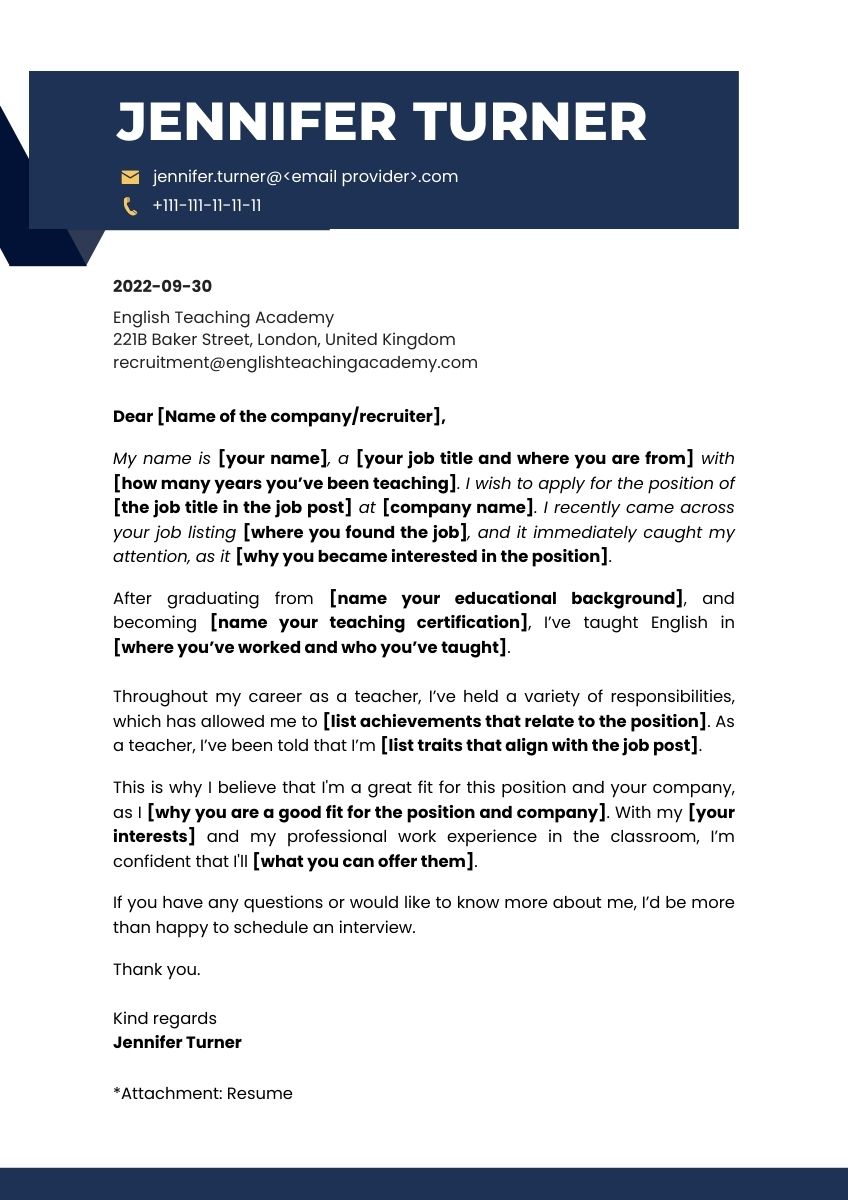
Template from Canva. (Click to enlarge)
Proofread your cover letter
Before you send your cover letter to the recruiter, make sure that you proofread it a few times. It can also be a good idea to have someone else, such as a friend or family member help proofread it as well. This is very important as you are expected to have a great command of grammar and writing as an English teacher.
Once you are satisfied with your letter, you can send it to the recruiter together with your resume/cv and your teacher training certificates.
Cover letter examples
Let’s now take a look at 4 examples of what an ESL cover letter can look like.
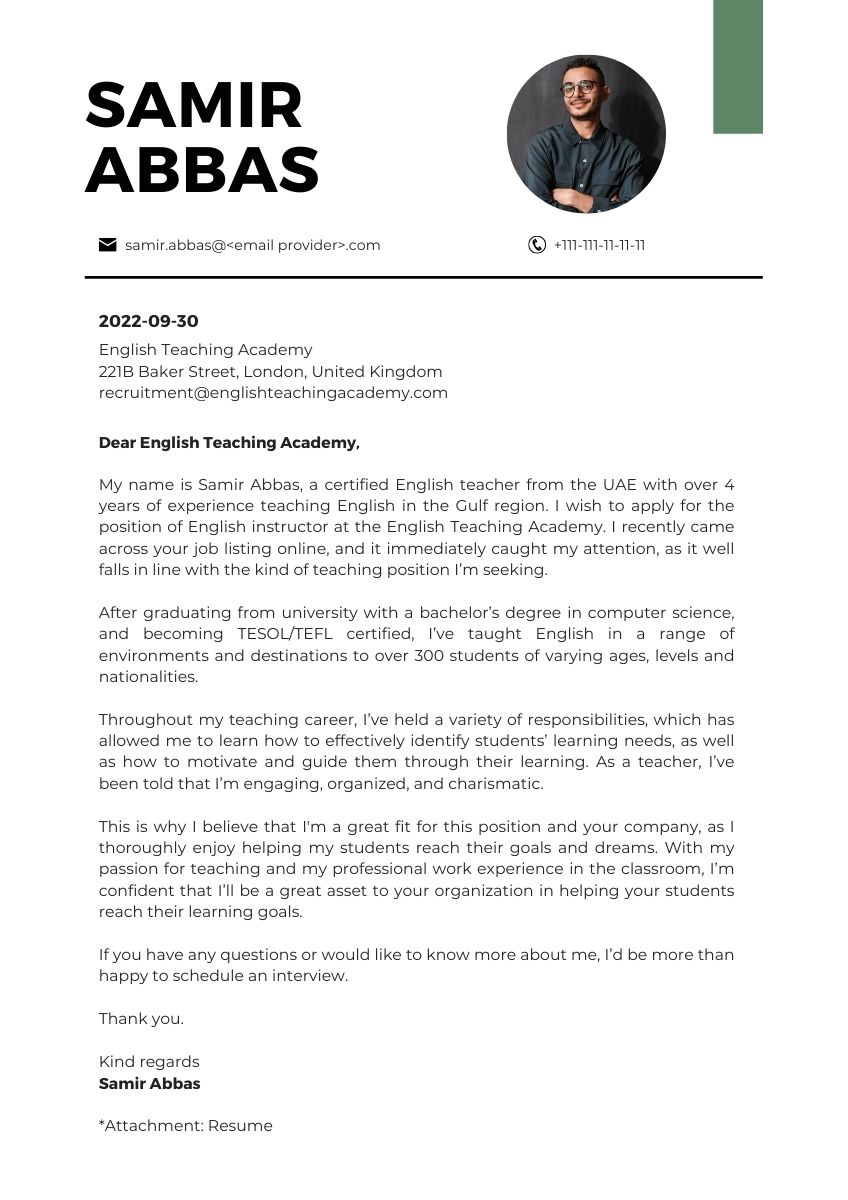
Template from Canva. (Click to enlarge)
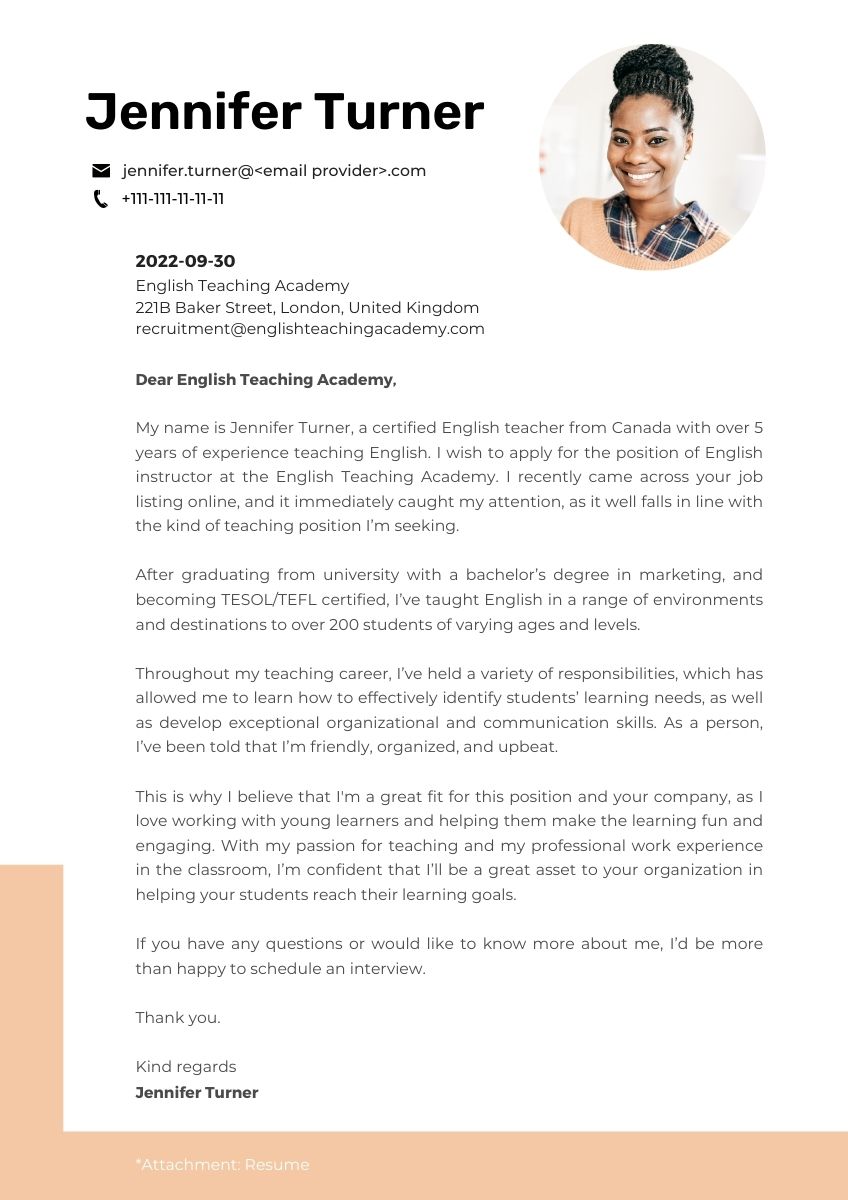
Template from Canva. (Click to enlarge)
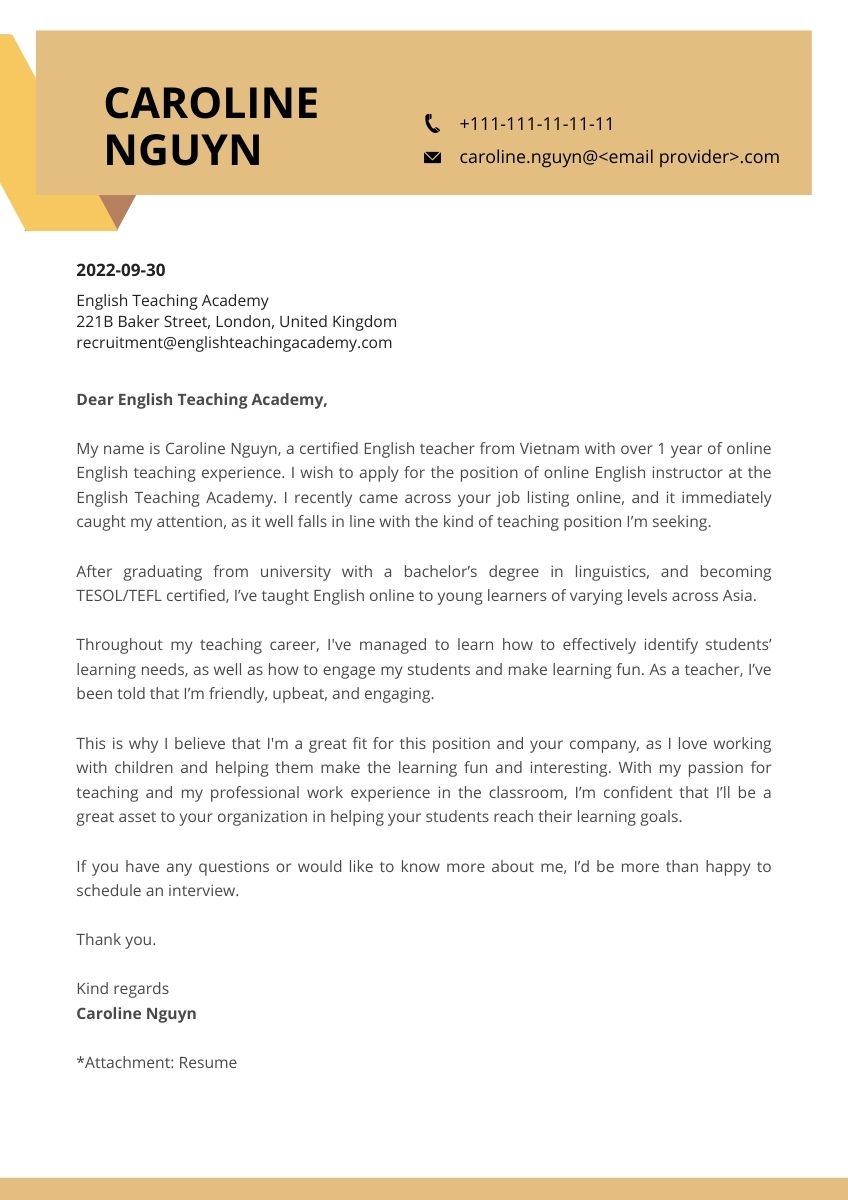
Template from Canva. (Click to enlarge)
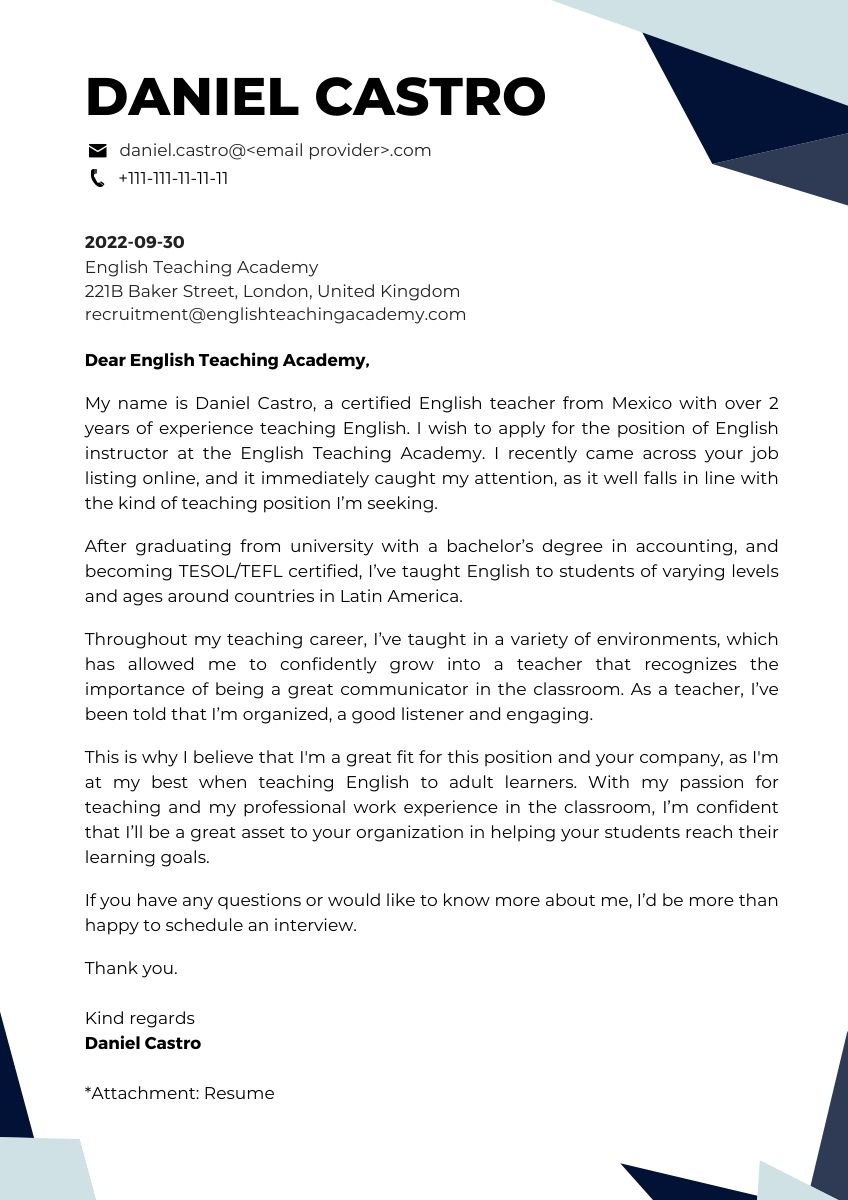
Template from Canva. (Click to enlarge)
Summary
While not all employers will expect to receive it, preparing a proper cover letter is crucial if you wish to maximise your chances of landing the job. It’s a fantastic opportunity to show the recruiter a little bit more of who you are which in turn can help influence your chances of being invited to an interview where you can truly show them what a fantastic teacher they will be hiring!
💡 Free job application resources: In addition to your cover letter, don’t forget to also prepare your ESL teaching resume, interview question answers, and other crucial documents that can help boost your chances.
You can find our handy guides here:
- ESL Resume Guide
- ESL Job Interview Guide – Part 1 & Part 2
- Top ESL Job Interview Questions – Part 1 & Part 2
With these tools in hand, you’ll be well-equipped to handle all parts of the interview process and land your next teaching job!
.

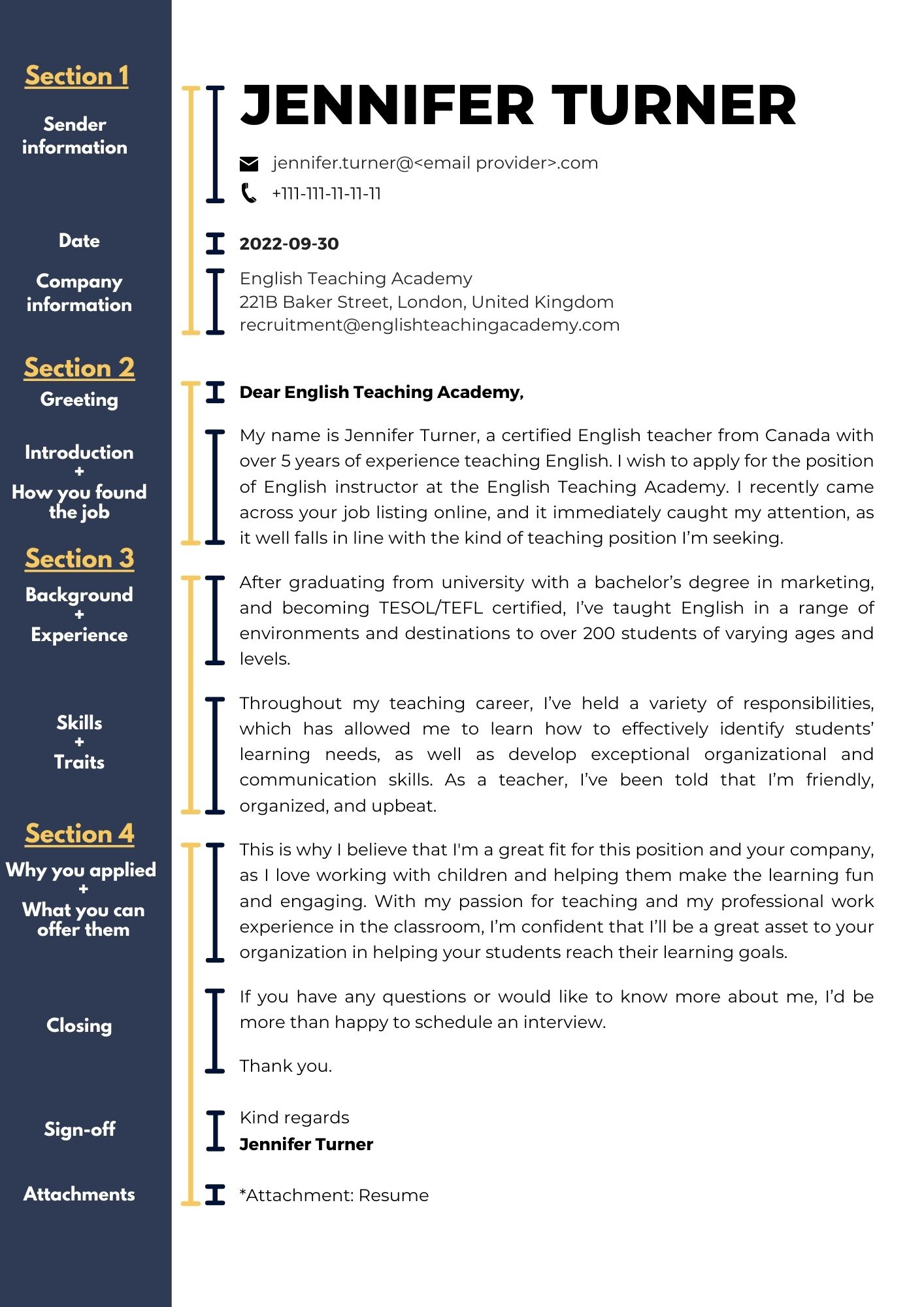
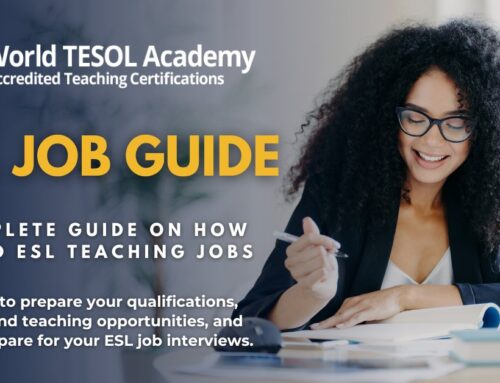


Thanks for the quick guide. However, I have some reservations on the cover letter. I think it’s rather too long. It contains so much information that can be found on the resume. I’ll rather suggest a concise version of what you already have
Thank you so much.
It was very use full